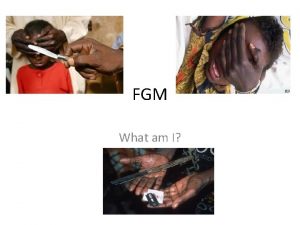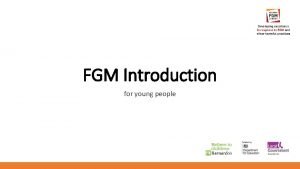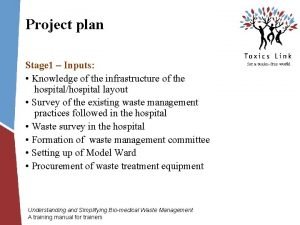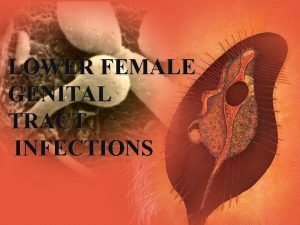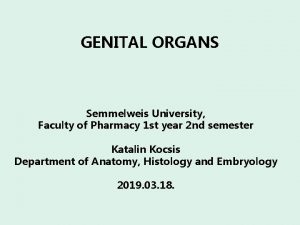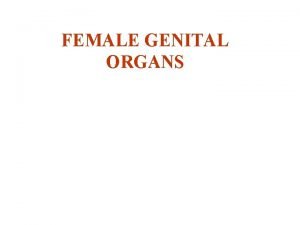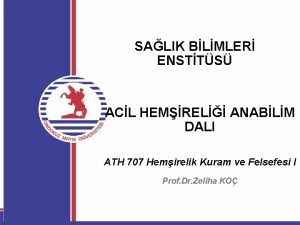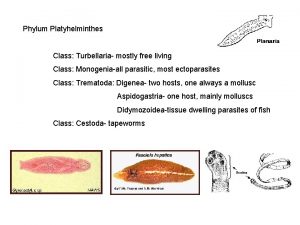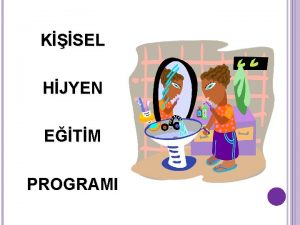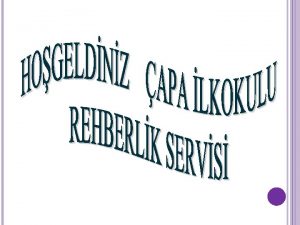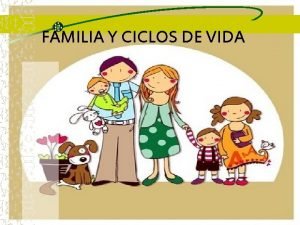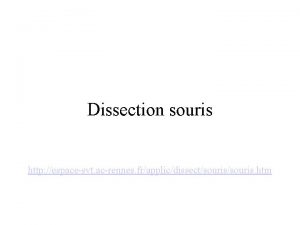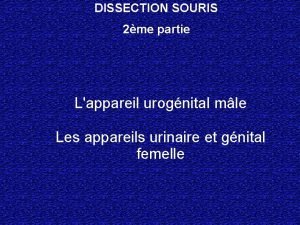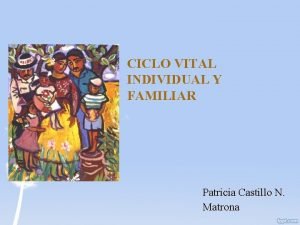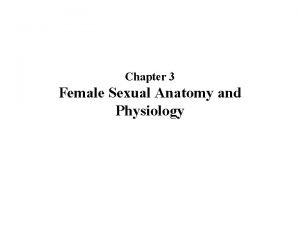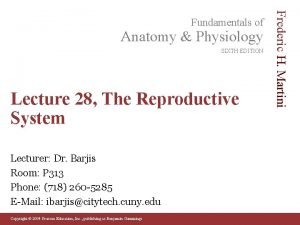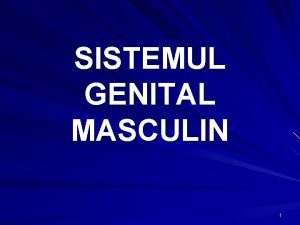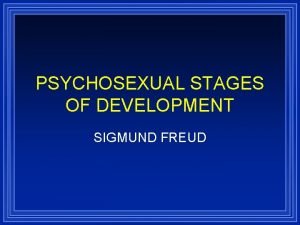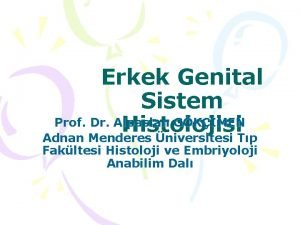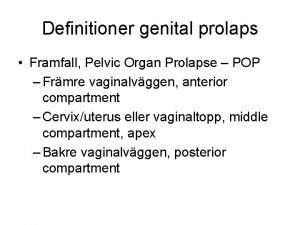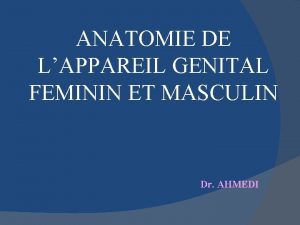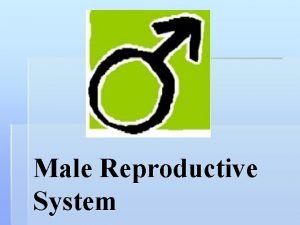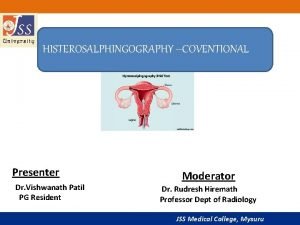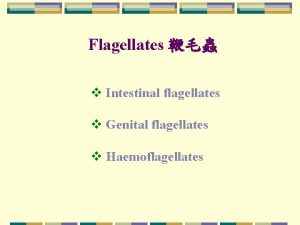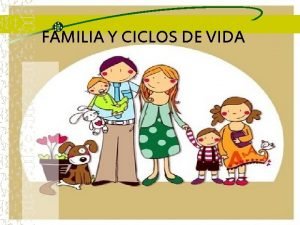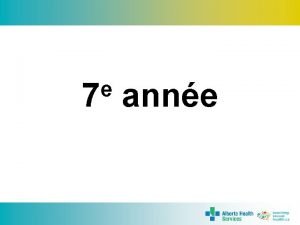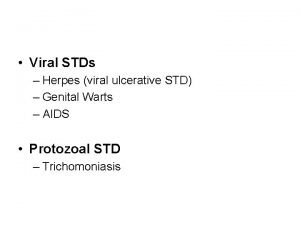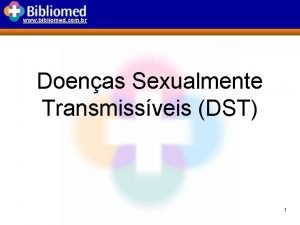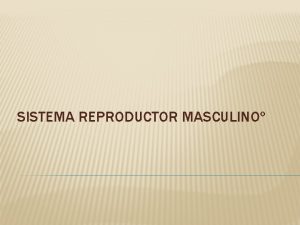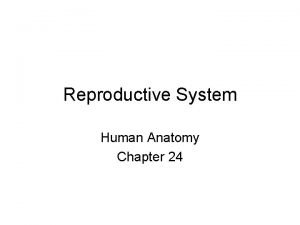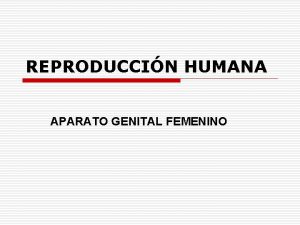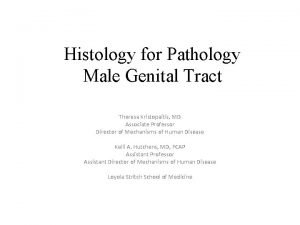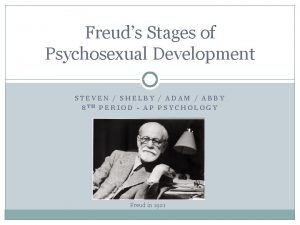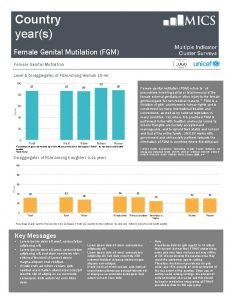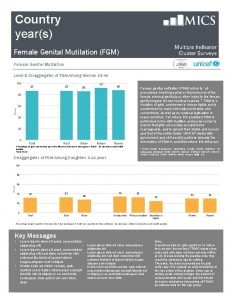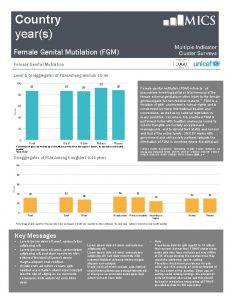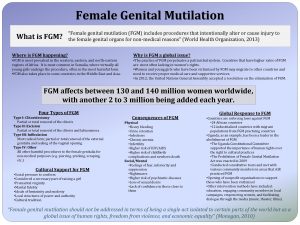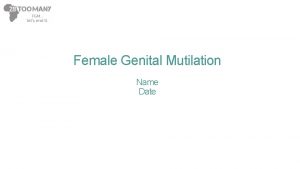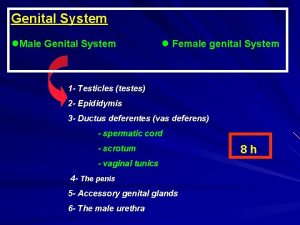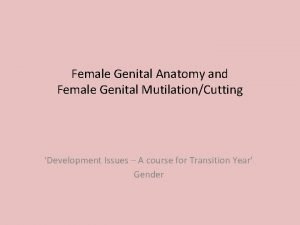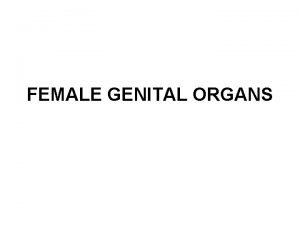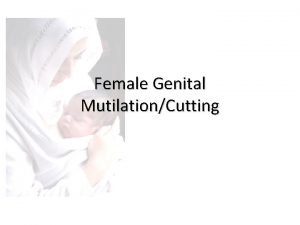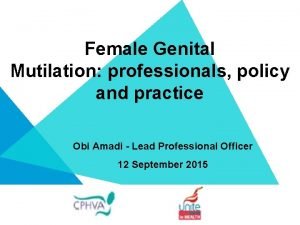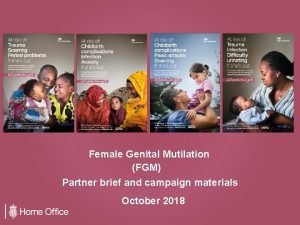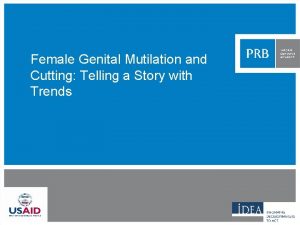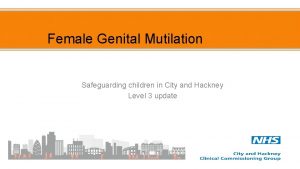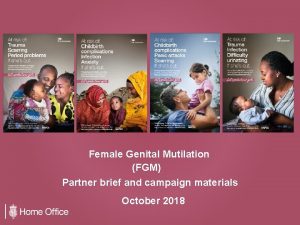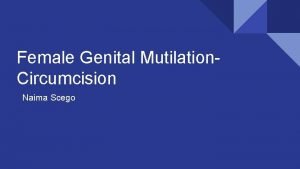IT IS A CRIME FEMALE GENITAL MUTILATION AND























































- Slides: 55

IT IS A CRIME: FEMALE GENITAL MUTILATION AND CHILD MARRIAGE Presented by: Keerthana Nimmala, Esq. Mariama Diallo, MSW Bushra Husain, LCSW-R OVS Conference November 9, 2016

AGENDA • Introduction and Assumptions • Global and U. S. Statistics • What is FGM and Forced Marriage? • Motives, Tactics, and Consequences • Legal Framework and Advocacy • Case Studies • Safety Planning and Resources

COMMON ASSUMPTIONS • FGM and forced marriage do not occur in the U. S. • Forced marriage is carried out by mostly immigrant communities. • Forced marriage is the same as arranged marriage. • FGM and forced marriage are religious practices. • Only children are at risk of FGM and forced marriage. • Forced marriage only affects women and girls. • Forced marriage requires physical force. • FGM only has physical consequences. • FGM is not a crime in the U. S. • There are no laws in the U. S. that can protect people from forced marriage.

GLOBAL & U. S. STATISTICS

WHERE IS FGM PERFORMED? • At least 200 million women and girls have undergone FGM around the world (UNICEF, 2016). • FGM is most prevalent in 30 countries in Africa, the Middle East, and Asia. • There also reports of FGM in Australia, Europe, North America, and South America.

HOW IS FGM PERFORMED? • Performed by elderly women • Who don’t have any medical knowledge • By using knives, scissors, broken glass and razor blades. • Anesthetics and antiseptic treatment are not generally used. • The instruments are not sterilized • Same tool is used for a group of girls • Ages vary

HIGHEST GLOBAL INCIDENCE OF FGM Somalia Guinea Djibouti Sierra Leone 98% 97% 93% 90% Gambia Ethiopia Mauritania Liberia 75% 74% 69% 50% Mali Egypt Sudan Eritrea Burkina Faso 89% 87% 83% 76% Guinea. Bissau Chad Cote d’Ivoire Nigeria Senegal 45% UNICEF, 2016. 44% 38% 25% • Nearly half of girls under 12 in Indonesia have undergone FGM (UNICEF). • At least 50 -60% of women in the Bohra community in India have undergone FGM (IRIN News). • About 40% of Iraqi Kurdish women and girls ages 11 -24 have undergone FGM (Human Rights Watch). • The prevalence rate for FGM in Yemen is 19% (UNICEF).

FGM IN THE UNITED STATES • An estimated 513, 000 women and girls in the U. S. are at risk of FGM (Centers for Disease Control & Prevention, 2016). Population Reference Bureau, 2015.

FGM IN THE UNITED STATES • The highest number of at-risk women and girls live in the following metropolitan areas: 1. New York, Newark, Jersey City 65, 893 2. Washington, Arlington, Alexandria 51, 411 3. Minneapolis, St. Paul, Bloomington 37, 417 4. Los Angeles, Long Beach, Anaheim 23, 216 5. Seattle, Tacoma, Bellevue 22, 923 6. Atlanta, Sandy Springs, Roswell 19, 075 7. Columbus 18, 154 8. Philadelphia, Camden, Wilmington 16, 417 9. Dallas, Fort Worth, Arlington 15, 854 10. Boston, Cambridge, Newton 11, 347 Population Reference Bureau, 2015.

GLOBAL PREVALENCE OF CHILD MARRIAGE • More than 700 million women and girls around the world were married before their 18 th birthday (UNICEF, 2016). Council of Foreign Relations/UNICEF, 2013

GLOBAL PREVALENCE OF FORCED MARRIAGE • The countries for which there is no data on child brides are not countries were child marriage does not exist. • In fact, many of those countries, e. g. , United Kingdom, have recognized and created protections for victims of forced marriage in recent years. • The map focuses on child marriage, which is only one form of forced marriage. Forced marriage also impacts adults from a wide range of backgrounds. UK Foreign & Commonwealth Office, 2013

FORCED MARRIAGE IN THE UNITED STATES • As many as 3, 000 known and suspected forced marriage cases in the U. S. were identified in a national survey (Tahirih Justice Center, 2011). • The survey found that forced marriage affected communities from at least 56 different countries of origin and various religious backgrounds, as well as nonimmigrant communities. India Sudan Vietnam Pakistan Bhutan Burkina Faso Mexico China Cambodia Bangladesh Iraq Ivory Coast The Philippines Nepal Laos Afghanistan Russia Mali Somalia Thailand Morocco Yemen Ethiopia Palestine Burma Iran Romania Guinea Jordan Saudi Arabia Tahirih Justice Center, 2011

HIDDEN FORMS OF ABUSE • FGM and forced marriage are often underreported. • FGM and forced marriage are seen as “cultural, ” not gender violence. • Victims of FGM and forced marriage are afraid of getting their families into trouble. • Forced marriage • Often confused with arranged marriage • Lack of working definitions • Occurrence alongside other practices of gender violence (ex. FGM, sexual assault, trafficking, and domestic violence) which victims may report first

WHAT IS FGM?

WHAT IS FGM? • Definition: • “All procedures involving partial or total removal of the external female genitalia or other injury to the female genital organs for non-medical reasons. ” World Health Organization (WHO) • Terminologies: FGM, FGM/C, excision, circumcision • Types: Clitoridectomy, excision, infibulation, and other

HOW IS FGM PERFORMED? • Performed by elderly women • Who don’t have any medical knowledge • By using knives, scissors, broken glass and razor blades. • Anesthetics and antiseptic treatment are not generally used. • The instruments are not sterilized • Same tool is used for a group of girls • Ages vary

WHAT IS FORCED MARRIAGE?

ARRANGED & LOVE MARRIAGES • Arranged marriage, generally refers to a marriage in which family or community members are involved in selecting the potential spouses, but the decision to accept or reject the arrangement remains with the individuals seeking marriage. • Historically, arranged marriage was viewed in different parts of the world as a means of uniting families, not just individuals. • Marriage was seen as opportunity to preserve, consolidate, or extend family property. • In joint/multigenerational households, marriage meant the bride would live not only with her new husband but also his extended family. • Love marriage, a term used in some communities, refers to a marriage decided upon by the couple, with or without consulting their family members.

WHAT IS FORCED MARRIAGE? • Forced marriage is the lack of full, free, and informed consent of one or both spouses. • Reasons for lack of consent include: • Lack of capacity to give valid consent (due to age or disability) • Presence of familial/community pressure, coercion, deception/fraud, or violence Even if an individual says “yes” to a marriage, that “yes” is only as meaningful as their ability to say “no. ”

THE MARRIAGE CONTINUUM • Forced marriage may be understood as one end of a continuum. • Dynamics in an intimate partner relationship can shift over time: • At different points before the marriage takes place. • After the marriage takes place. Arab American Family Support Center & Sanctuary for Families, 2015

ARRANGED MARRIAGE FORCED MARRIAGE • The continuum below is one conceptualization of how an arranged marriage could become a forced marriage later in time. Vidya Sri & Darakshan Raja, 2013

LOVE MARRIAGE FORCED MARRIAGE • A “love marriage” could also become a forced marriage. The following is an example of such a shift in an intimate partner relationship. Sanctuary for Families, 2015 • The inability to leave a relationship bring a forced marriage element to many domestic violence situations we are already familiar with.

MOTIVES, TACTICS & CONSEQUENCES

GENDER VIOLENCE • FGM and forced marriage are internationally recognized as violations of women and girls’ fundamental human rights. • FGM and forced marriage are interconnected and occur alongside other forms of gender violence. For example: • FGM and forced marriage have been carried out to punish victims of sexual assault and rape. • FGM often precedes a forced marriage. • FGM and forced marriage often lead to domestic violence, including psychological, physical, and sexual abuse.

MOTIVES FGM - Ensuring victim is marriageable - Belief that female genitals are impure - Controlling sexuality and preventing “unwanted” behavior - Ensuring conformity with traditional notions of femininity, e. g. docility, obedience - Protecting perceived religious and cultural norms - Protecting family “honor” - Fear of social exclusion Forced Marriage - Protecting longstanding family commitments - Achieving financial gain/status - Passing off care of victim with disability

TRIGGERING/ESCALATING FACTORS FGM Forced Marriage - Individual is from a family, ethnic group, or country that practices FGM - Family discovers individual is dating - Individual marries into an ethnic group that practices FGM - Individual approaches age by when women and girls must be subjected to FGM or married in her community - Individual has disability - Individual discloses sexual abuse/rape - Older sibling rejects marriage proposal - Individual is LGBTQ - There is an inter/intrafamily dispute

WHO IS BEHIND FGM & FORCED MARRIAGE? • Either or both parents • Siblings • Extended family members, e. g. , grandparents, aunts, uncles, cousins • (Potential) spouse and family • Family friends or community members

TACTICS • Emotional abuse, psychological manipulation, and threats of disownment/social exclusion • If you are not cut, you will never get married. • If you are not cut/married, you will be responsible for destroying your family’s honor. You will bring shame to our family. • If you are not cut/married, we will disown you and exclude you from our family and community. • If you are not cut/married, you will be ridiculed and ostracized by society. • If you don’t get married, I will commit suicide. • If you don’t get married, we will marry off your younger sister instead. • If you don’t get married, I will divorce your mother and send her back to her home country.

TACTICS • Fraud and deception • Kidnapping and abduction • Isolation and confinement in the home • Threats of actual physical violence or death • Other tactics in forced marriage situations: • Restrictions on movement, communication, and education or career choices • Constant surveillance and stalking • Threats to economic and immigration situation

CONSEQUENCES: PHYSICAL IMPACT FGM - Short-term health complications, e. g. , severe pain, excessive bleeding, shock, infections, urine retention, death - Long-term health complications, e. g. , cysts, painful urination and menstruation, reduction/ elimination of sexual pleasure and painful intercourse Forced Marriage - Rape and sexual abuse - Forced pregnancy - Gynecological and obstetric complications, including maternal and infant mortality - Increased risk of STIs and HIV/AIDS - Increased risk of domestic violence - Abandonment by spouse - Termination of education or employment outside home - Domestic servitude, forced labor, and sex trafficking

CONSEQUENCES: PSYCHOLOGICAL IMPACT PTSD DEPRESSION • Nightmares/upsetting dreams • Intrusive memories • Severe emotional distress or physical reactions to something that reminds them of the event • Flashbacks • Trauma avoidance • Overwhelming guilt or shame • Anxiety • Powerlessness/guilt • Sadness • Low self esteem/body image issues

LEGAL FRAMEWORK & ADVOCACY

IMMIGRATION PROTECTIONS AGAINST FGM • Asylum: Matter of Kasinga (1996) established that FGM is severe enough to be considered persecution under immigration law. • e. g. , past FGM, fear of future FGM, fear of FGM to daughter(s) • Asylum applications must be filed within one year of last arrival in U. S. unless exceptional or changed circumstances are proven. • Other options: • VAWA self-petition (for spouses/children of abusive U. S. citizens/ permanent residents) • U visa (for victims of crimes in the U. S. ) • Special Immigrant Juvenile Status (for abused/abandoned/neglected children)

FEDERAL CRIMINAL LAWS AGAINST FGM • 18 USC § 116: In 1996, Congress enacted legislation making performance of FGM on a minor a felony. • “Culture” excluded as a defense: “[N]o account shall be taken of. . . any belief . . . that the operation is required as a matter of custom or ritual. ” • To evade law, family members increasingly sent women and girls overseas to undergo FGM, typically during school vacations. • Transport for Female Genital Mutilation Act: In 2013, the federal law was amended to criminalize this practice of “vacation cutting” of minors, with advocacy from Sanctuary for Families and other organizations.

STATE CRIMINAL LAWS AGAINST FGM • Twenty-four states have laws that specifically criminalize FGM. • Some extend protections beyond the federal law (e. g. , victim does not have to be minor). Equality Now, 2016.

ADVOCATING FOR STATE PROTECTIONS AGAINST FGM • Sanctuary for Families, in partnership with other organizations, advocated for the passage of additional New York State protections that would equip local first line responders (e. g. , state prosecutors, medical professionals, educators) with tools to prevent FGM. • New York State Bill A 134/S 3483 amends the state’s public health law to provide for public education and outreach about FGM (signed into law 2015) • New York State Bill AS 3484 criminalizes removal of a minor from the state for the purposes of FGM (signed into law 2016)

CHILD MARRIAGE IN NEW YORK • 3, 853 minors were married in NYS between 2000 and 2010 (NYS Dept. of Health). • More than 84% were minor girls wed to adult men (NYS Dept. of Health).

PREVIOUS NYS DOMESTIC RELATIONS LAW • Permitted the marriage of 14 - and 15 -year-olds with parental consent and judicial approval. • Permitted 16 - and 17 -year olds to marry with parental consent. • Failed to provide an opportunity for a minor to voice his or her consent or lack thereof. • Failed to provide guidelines for courts to consider when issuing approval, or to articulate when denying a marriage petition involving a minor.

NEW NYS CHILD MARRIAGE LAW • Amends DRL § 15 to prohibit any marriage of children ages 16 and younger. Minors aged 17 can marry only with judicial review and authorization. • Includes a rigorous judicial review process to ensure that 17 -yearold applicants for marriage are not being pressured, coerced, or forced into marriage and that the marriage will not undermine the minor’s safety and well-being. • The new child marriage law provides a list of specific factors for courts to consider when assessing whether to authorize the marriage of a minor or minors.

FACTORS FOR JUDICIAL CONSIDERATION The statute provides a list of four key factors for courts to consider when assessing whether to authorize the marriage of a 17 -year-old. • Age difference between the parties • History of domestic violence between the parties or a party and the other party’s family • Whethere is a power imbalance between the parties • Whether the parties are incapable of understanding or consenting to the marriage

BACKGROUND CHECKS The amendment requires that the court conduct the following background checks: • Related court decisions, if any, pursuant to Article 10 of the Family Court Act • All warrants, if any, issued under the Family Court Act • Reports of the statewide Orders of Protection Registry • Reports, if any, of the Sex Offender Registry

ATTORNEY FOR THE CHILD • The law provides for the appointment of an attorney for the child to the minor party to the marriage. • The statute provides that the attorney for the child “shall have received training in domestic violence including a component on forced marriage. ”

NOTIFICATION TO THE MINOR OF RIGHTS • The attorney for the child must provide the minor with the Office of Court Administration (OCA) notification sheet. It contains important legal information for minors applying for marriage. • Divorce: “You always have the right to end your marriage (get divorced) if you meet the legal requirements. ” • Financial Matters: “If you get divorced, you may be able to get financial support from your spouse, or your spouse may be able to get financial support from you. ” • Child Custody: “If you separate or divorce, and you have children with your spouse, either of you may ask the court for custody of the children. ”

IN CAMERA INTERVIEW • The new law requires the court to conduct an in camera interview with any minor party in an application for marriage. • Understand that your minor client may be frightened of disclosing any family pressure and/or violence. • Explain your and the court’s obligations of confidentiality. • Consider submitting a list of questions for the court to ask your client.

WRITTEN AFFIRMATIVE FINDINGS • The judge must issue a written finding that the minor is “entering the marriage of his/her own free will. ” • The judge must find that “the minor is not being compelled [to enter the marriage] by force, threat, persuasion, fraud, coercion, or duress; ” AND • That the marriage will not “endanger the mental, emotional, or physical safety of the minor. ”

IMMIGRATION PROTECTIONS AGAINST FORCED MARRIAGE • Asylum: e. g. , client flees from forced marriage abroad; client’s family in the U. S. threatens to have her deported and forced into marriage abroad • VAWA self-petition: e. g. , client’s U. S. permanent resident father threatens he won’t sponsor her for green card unless she marries • U visa: e. g. , client raped by partner who blackmails her to marry him • T visa: e. g. , client sold by family to spouse in exchange for bride price; client kept in domestic/sexual slavery by spouse and family • Special Immigrant Juvenile Status: e. g. , client’s parents threaten to force her into marriage; client’s parents force her into religious, but not civil, marriage

PROTECTIONS FOR U. S. CITIZENS AGAINST FORCED MARRIAGE • Withdrawal of sponsorship of spouse: e. g. , U. S. citizen client’s family applied for her foreign spouse’s green card without her knowledge or consent • 7 Foreign Affairs Manual 1741: The U. S. Department of State “considers a forced marriage to be a violation of basic human rights. It also considers the forced marriage of a minor child to be a form of child abuse, since the child will presumably be subjected to nonconsensual sex. ”

STATE PROTECTIONS AGAINST FORCED MARRIAGE Criminal Offenses: • Stalking • Menacing • Assault • Unlawful imprisonment • Kidnapping • Trafficking • Sexual abuse/rape • Endangerment of child welfare • Coercion Family Law Remedies: • Orders of protection • Annulment (e. g. , nonage; fraud/coercion) • Divorce • Child abuse/neglect proceedings

CASE STUDIES

FATIMA AND NALA Fatima and Nala are sisters born in the US from an immigrant West African family. Their parents came to the US years ago for a better life. The family is well known and respected within the African community in New York. They are educated and hard working parents but also very traditional and proud of their culture. Fatima and Nala’s parents were determined to teach them about their culture and tradition. When Fatima and Nala were respectively 7 and 8 years old, they were told that they will go to West Africa to visit their parents’ families and meet with other family members including their grandmothers and learn their culture and language. Fatima and Nala were growing up as normal children, going to elementary school, making friends and were overall happy. That summer, Fatima and Nala were sent alone to West Africa by their parents to spend time with their extended family on “vacation”. FGM being a taboo subject, they had never heard about it even though their mother is a survivor. While on “vacation”, they were subjected to FGM by their paternal grandmother. Before the FGM their grandmother told them that she was taking them somewhere to celebrate their transition into womanhood. Fatima and Nala didn’t know what was about to happen. They were taken to another place, held down, blindfolded and their genitals were cut off without anesthesia.

FATIMA AND NALA When Fatima and Nala came back to the US, they felt betrayed, ashamed, isolated, and sad and withdrew from their peers. Now they are 15 and 16 but their experience has never been discussed in their family. They have been told that they cannot see a gynecologist for fear of getting their family in trouble. Questions: How do you assess the risks? What do you think is the best way to address FGM with families? What can we do to help Fatima and Nala now?

CASE STUDY: “HEBA” Heba is the youngest of 4 siblings and originally from Pakistan. Her family migrated to the U. S. when she was 9 years old. After just graduating from high school, Heba and her family took a trip to Pakistan as her brother was getting married. The marriage was arranged by Heba’s parents and the family of the bride, who was not related. Heba did not realize that during this trip she would also be returning to the U. S. engaged. In Pakistan, Heba’s father had a heated argument with his older brothers who resented him for not helping the family financially and for not having his sons marry their first cousins. In order to appease his brothers, Heba’s father had Heba engaged to her first cousin. No one asked Heba if she wanted to get married. Upon returning to the U. S. , Heba had doubts about marrying her cousin she barely knew but she pushed away the thoughts knowing that this was customary tradition followed by her family. She feared speaking up as her older sister ran away from home and eventually married outside of her religion. Heba's older sister was disowned by the father and her name was never to be mentioned in the home.

CASE STUDY : “HEBA” Heba soon got a job at the airport and fell in love with Umar. When her father and brothers found out, they forced Heba to leave her job. She was now forbidden to leave the home or have access to the Internet or her cellphone. She was beaten by her brothers and at times, handcuffed to a bed. The curtains were closed and she recalls not visibly seeing the sun for over 3 months. During this time, Heba became very depressed and began cutting. She even attempted suicide which prompted her father to enroll her in a local vocational training program. However, her brothers were to accompany her at all times; they picked her up after her classes and she was not allowed to stay behind on campus to speak with classmates or participate in extracurricular activities and events.

SAFETY PLANNING & RESOURCES • Possibility of domestic violence shelter • Reminding the client that marriage requires consent • Reminding the client that FGM is a crime • Informing the client that s/he can call 911 • Identifying an escape route or safe place • Conducting risk assessment of going abroad, providing contact information for nearest U. S. consulate and the U. S. Department of State Office for Overseas Citizens Services*, and making copies of important documents • *From the U. S. & Canada 1 -888 -407 -4747 • *From Overseas +1 202 -501 -4444 • When working with a minor, notifying Child Protective Services • FGM: Contact Human Rights and Special Prosecutions Section (HRSP) at 1 -800 -8135863 or at HRSPTIPS@USDOJ. GOV

CONTACT INFORMATION For more information, please visit www. sanctuaryforfamilies. org or contact us at: Mariama Diallo, MSW African Community Specialist Sanctuary for Families (212) 349 -6009 x 310 mdiallo@sffny. org Bushra Husain, LCSW-R Supervising Social Worker Sanctuary for Families (212) 349 -6009 x 311 bhusain@sffny. org Sayoni Maitra, Esq. Staff Attorney Sanctuary for Families (212) 349 -6009 x 499 smaitra@sffny. org
 Female genital mutilation
Female genital mutilation Mutilation meaning
Mutilation meaning Mutilation of waste
Mutilation of waste Defense mechanism of female genital tract
Defense mechanism of female genital tract Angle of anteversion uterus
Angle of anteversion uterus Female sex anatomy diagram
Female sex anatomy diagram Function of fallopian tube
Function of fallopian tube Genital parasite
Genital parasite Male genital variation
Male genital variation Genital hijyen
Genital hijyen Fijacion en la etapa anal
Fijacion en la etapa anal Phylum platyhelminthes class turbellaria
Phylum platyhelminthes class turbellaria Genital hijyen
Genital hijyen Genital hijyen nedir
Genital hijyen nedir Historia natural del herpes genital
Historia natural del herpes genital Hsv-2 oral transmission rates
Hsv-2 oral transmission rates Ciclos de familia
Ciclos de familia What phylum do sharks belong to
What phylum do sharks belong to Appareil génital souris femelle
Appareil génital souris femelle Appareil génital souris femelle
Appareil génital souris femelle Ciclo vital individual y familiar
Ciclo vital individual y familiar Etapa post parental
Etapa post parental Female external reproductive system
Female external reproductive system Taenia egg
Taenia egg External genital
External genital Male function
Male function Spermatogonii
Spermatogonii Sigmund freud's psychosexual development
Sigmund freud's psychosexual development Erogenous zone in oral stage
Erogenous zone in oral stage Grávidas tem corrimento
Grávidas tem corrimento Testis nedir
Testis nedir Vaginalt enterocele
Vaginalt enterocele L'appareil génital féminin en coupe frontale
L'appareil génital féminin en coupe frontale Functions of cowpers gland
Functions of cowpers gland Genital tb
Genital tb Mott cell histology
Mott cell histology Etapa incorporativa
Etapa incorporativa Kira nadine first meeting
Kira nadine first meeting Sistemul genital masculin
Sistemul genital masculin How to determine the sex of a fetal pig
How to determine the sex of a fetal pig Schéma de la fécondation à la nidation
Schéma de la fécondation à la nidation Genital herpe
Genital herpe Canal ejaculator
Canal ejaculator Papilomavírus humano
Papilomavírus humano Partes del organo reproductor masculino
Partes del organo reproductor masculino Mesovariun
Mesovariun Aparato reproductor femenino partes
Aparato reproductor femenino partes Urospermiducte
Urospermiducte Vesicula seminal função
Vesicula seminal função What does the prostate do
What does the prostate do Genital warts
Genital warts Tubuli recti
Tubuli recti Genital infections
Genital infections Fixation in oral psychosexual stage
Fixation in oral psychosexual stage Genital infections
Genital infections Etapa genital
Etapa genital
